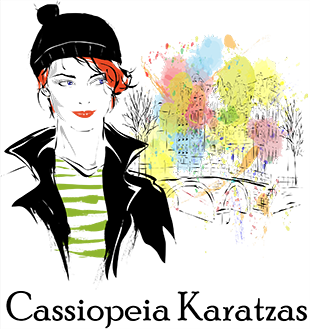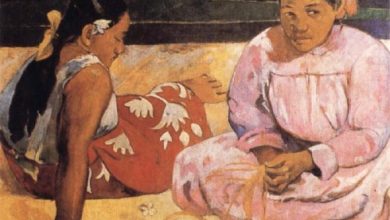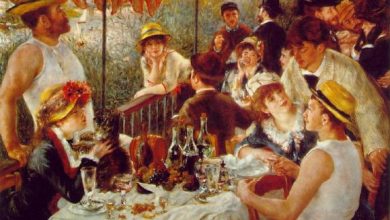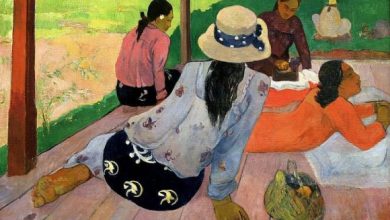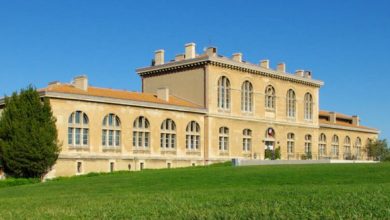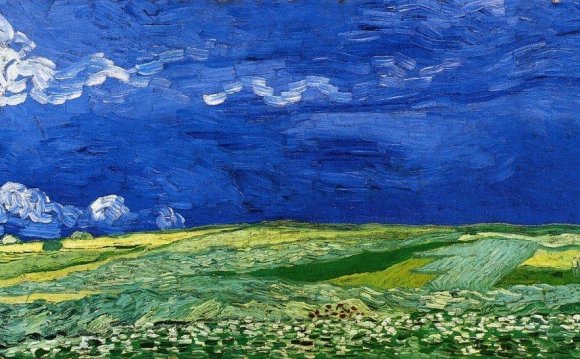
During the ten years that Vincent van Gogh painted, he depicted many different genres; portraits, landscapes, and still lifes. Some of those still lifes were of bottles, chairs, shoes, or famously, flowers. From Van Gogh’s Sunflowers, to his Irises, or his Roses, he brought life and emotion to his work – taking a subject matter that has been painted since the beginning of art and putting his unique perspective on it. Van Gogh painted Vase with Honesty in 1884, and would continue to paint flowers throughout his career. For an artist like van Gogh, who was struggling to sell work and earn a living, money was always an issue. Painting flowers was an inexpensive endeavor, and van Gogh wrote
“And now for what regards what I myself have been doing, I have lacked money for paying models, else I had entirely given myself to figure painting but I have made a series of colour studies in painting simply flowers, red poppies, blue corn flowers and myosotys. White and rose roses, yellow chrysanthemums.”
In 1885 van Gogh was painting portraits of peasants and completed his first major work, The Potato Eaters. Having just moved to Paris Vincent was encouraged by his brother to paint brighter, more colorful paintings, and his flower still lifes from this period, in 1886, reflect this. They are still predominantly dark, dominated by earth tones, but the flowers are becoming more vibrant and showing more color. Paintings like Glass with Roses and Vase with Carnations show flowers set against a dark background, only the flowers with any sense of bright color. Roses shine in yellow, carnations bloom bright white, red, and yellow, contrasting against the dark backdrop.
For, Theo, with painting my real career begins. Don’t you think I am right to consider it so?”
Some paintings from this period show vases with a few small blooms, while others, like Vase with Gladioli and Lilac and Poppy Flowers show vases overflowing with arrangements. Van Gogh had been studying the still life paintings made famous by master Flemish painters. This period marks a turning point in his artistic career where van Gogh is moving away from the darker paintings he was producing in the Netherlands and becoming interested in the more colorful works of the Impressionists. Van Gogh was developing his masterful use of color theory “seeking oppositions of blue with orange, red and green, yellow and violet.”
The next year saw Vincent painting much brighter paintings. His self-portraits, landscapes, and flower paintings were showing softer tones, lighter backgrounds, and beginning to show his quick brush strokes. Van Gogh’s flowers from 1887, including Vase with Lilacs, Daisies and Anemones, show flowers in a blue vase set against a soft blue and purple background. This was a period where van Gogh consciously was trying to add color to his painting. He wrote “I painted almost nothing but flowers to accustom myself to a colour other than grey, that’s to say pink, soft or bright green, light blue, violet, yellow, orange, fine red.”
When van Gogh was painting in Arles, in the south of France, he was looking forward to his friend Gauguin coming to live and paint with him. In anticipation for his arrival van Gogh painted Sunflowers to decorate the house. Sunflowers became a series with many canvases depicting the same subject matter. Painted in 1888 and 1889, van Gogh’s Sunflowers show a yellow vase on a table containing yellow sunflowers in different stages of life. Some are just blooming, some are open and vibrant, and some are withering and dead. Gauguin appreciated the gesture, and displayed some of van Gogh’s Sunflower paintings in his bedroom.
After traumatic episodes in Arles, van Gogh went to an asylum in Saint-Remy, France. In the first week he was there Vincent painted the irises in the asylums garden. In Irises, Vincent shows a row of blue irises atop bright green stem and leaves. In the immediate foreground a patch of iris flowers are just visible at the bottom of the picture. The pattern created by the leaves and groups of iris flowers was influenced by Japanese woodcuts that van Gogh was interested in. Vincent painted Irises as a study, but when his brother Theo saw it he thought it was a marvelous painting showing Vincent’s talent for composition and use of color and entered it in the Salon des Indépendants of 1889. Along with Sunflowers, Irises has become one of van Gogh’s most enduring and popular paintings.
At the end of van Gogh’s stay at Saint-Remy he was feeling good about himself and his illness. In the days before Vincent left the asylum he felt that he would not be having and mental upsets easily and wrote “I tell you, as regards work, my mind feels absolutely serene and the brushstrokes come to me and follow each other very logically.”
